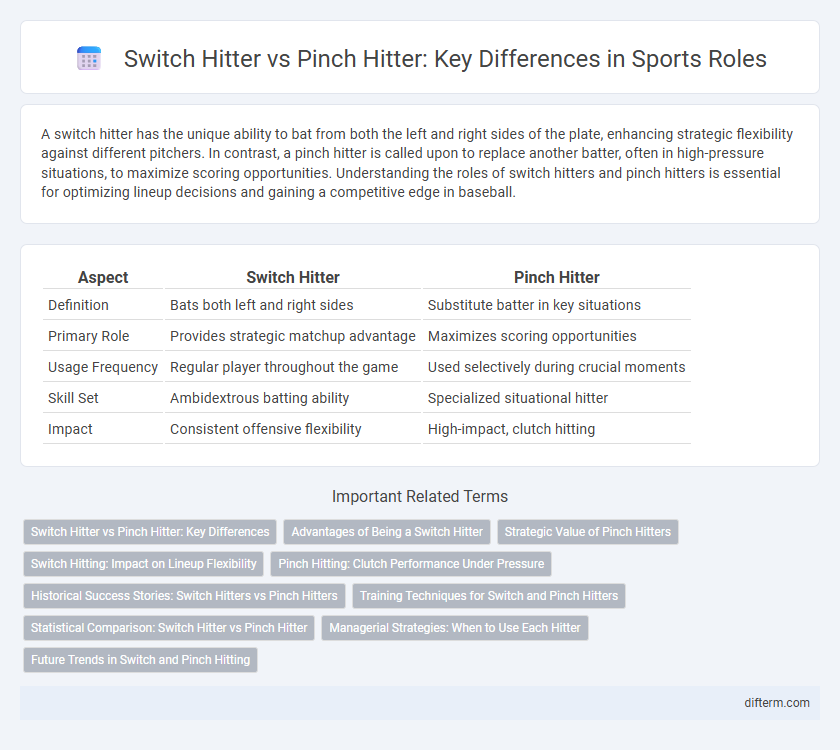A switch hitter has the unique ability to bat from both the left and right sides of the plate, enhancing strategic flexibility against different pitchers. In contrast, a pinch hitter is called upon to replace another batter, often in high-pressure situations, to maximize scoring opportunities. Understanding the roles of switch hitters and pinch hitters is essential for optimizing lineup decisions and gaining a competitive edge in baseball.
Table of Comparison
| Aspect | Switch Hitter | Pinch Hitter |
|---|---|---|
| Definition | Bats both left and right sides | Substitute batter in key situations |
| Primary Role | Provides strategic matchup advantage | Maximizes scoring opportunities |
| Usage Frequency | Regular player throughout the game | Used selectively during crucial moments |
| Skill Set | Ambidextrous batting ability | Specialized situational hitter |
| Impact | Consistent offensive flexibility | High-impact, clutch hitting |
Switch Hitter vs Pinch Hitter: Key Differences
Switch hitters possess the unique skill of batting from both the left and right sides of the plate, providing strategic advantages against pitchers of varying handedness. Pinch hitters, on the other hand, are substitute batters brought in during critical game moments to replace a teammate, often chosen for their specialty hitting against specific pitchers. The main difference lies in the switch hitter's consistent dual-sided batting ability versus the pinch hitter's situational, often singular at-bat role.
Advantages of Being a Switch Hitter
Switch hitters gain a significant tactical advantage by batting from both sides of the plate, enabling them to exploit pitcher matchups and reduce the risk of facing a disadvantageous matchup. This versatility increases their batting average and on-base percentages by consistently putting them in a position to see the ball better and react more effectively. Their capability to adjust to various pitchers makes them valuable assets in lineup flexibility and enhances overall team offensive strategy.
Strategic Value of Pinch Hitters
Pinch hitters offer strategic value by providing teams with situational offensive advantages, especially during critical moments in a game. Unlike switch hitters who rely on natural ambidexterity to neutralize pitching matchups, pinch hitters are chosen for their specific ability to perform well against a particular pitcher or in high-pressure at-bats. Managers leverage pinch hitters to exploit pitcher weaknesses, improve run production, and increase the likelihood of key hits that can change the outcome of an inning or game.
Switch Hitting: Impact on Lineup Flexibility
Switch hitting significantly enhances lineup flexibility by allowing players to bat effectively from both sides of the plate, mitigating pitcher matchups and defensive shifts. This versatility enables managers to optimize batting order strategies and maintain offensive consistency against a broader range of pitchers. Teams with proficient switch hitters benefit from increased tactical options, improving run production and in-game adaptability.
Pinch Hitting: Clutch Performance Under Pressure
Pinch hitting demands exceptional focus and adaptability, as players enter the game cold and face pitchers with minimal preparation. Success rates for pinch hitters typically lag behind starters, yet their ability to deliver critical hits in high-leverage situations makes them invaluable in late innings. Analytics highlight that clutch pinch hitters often possess increased batting averages and on-base percentages during key scoring opportunities, underscoring their strategic importance in baseball.
Historical Success Stories: Switch Hitters vs Pinch Hitters
Switch hitters like Mickey Mantle and Chipper Jones have historically demonstrated remarkable versatility at the plate, enabling them to maintain high batting averages against both left- and right-handed pitchers. Pinch hitters such as Lenny Harris and Kirk Gibson became legendary for clutch performances, often changing the course of crucial games with timely hits off the bench. The strategic deployment of switch hitters and pinch hitters in baseball history highlights their unique contributions to team success and game dynamics.
Training Techniques for Switch and Pinch Hitters
Training techniques for switch hitters emphasize ambidextrous batting drills, focusing on developing muscle memory from both sides of the plate through repetitive tee work, soft toss, and live pitching simulations. Pinch hitters concentrate on situational hitting practice, including timing drills and visualization strategies to prepare for high-pressure at-bats with limited warm-up. Both roles benefit from video analysis and mental conditioning to enhance adaptability and quick decision-making during games.
Statistical Comparison: Switch Hitter vs Pinch Hitter
Switch hitters maintain higher overall batting averages, often ranging between .260 and .280, due to their ability to adapt to different pitching styles, whereas pinch hitters typically have lower averages near .230, influenced by limited at-bats and high-pressure situations. On-base percentage (OBP) for switch hitters generally exceeds .340, benefiting from consistent plate appearances, while pinch hitters average closer to .300, reflecting sporadic and specialized usage. Slugging percentage (SLG) trends higher for switch hitters around .430, compared to pinch hitters who usually record SLG near .380, highlighting the power advantage of regular hitters over situational substitutes.
Managerial Strategies: When to Use Each Hitter
Managers deploy switch hitters strategically to exploit matchups by adjusting batting stance against different pitchers, maximizing offensive potential across varied pitching styles. Pinch hitters are used primarily in high-leverage situations to replace weaker batters late in the game, targeting specific pitcher weaknesses or aiming for clutch hits. Optimal use of switch hitters and pinch hitters enhances lineup flexibility and can shift game momentum through informed, situation-specific decisions.
Future Trends in Switch and Pinch Hitting
Switch hitting is poised for growth as players increasingly develop ambidextrous batting skills to exploit matchup advantages against pitchers. The strategic use of pinch hitters will evolve with data analytics, identifying optimal moments to deploy specialized hitters to maximize scoring opportunities. Advances in biomechanics and training technology further enhance switch hitters' adaptability, potentially transforming lineup flexibility in professional baseball.
switch hitter vs pinch hitter Infographic

 difterm.com
difterm.com